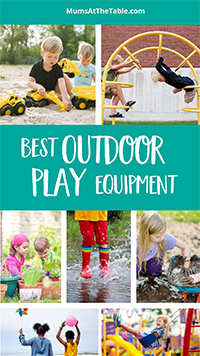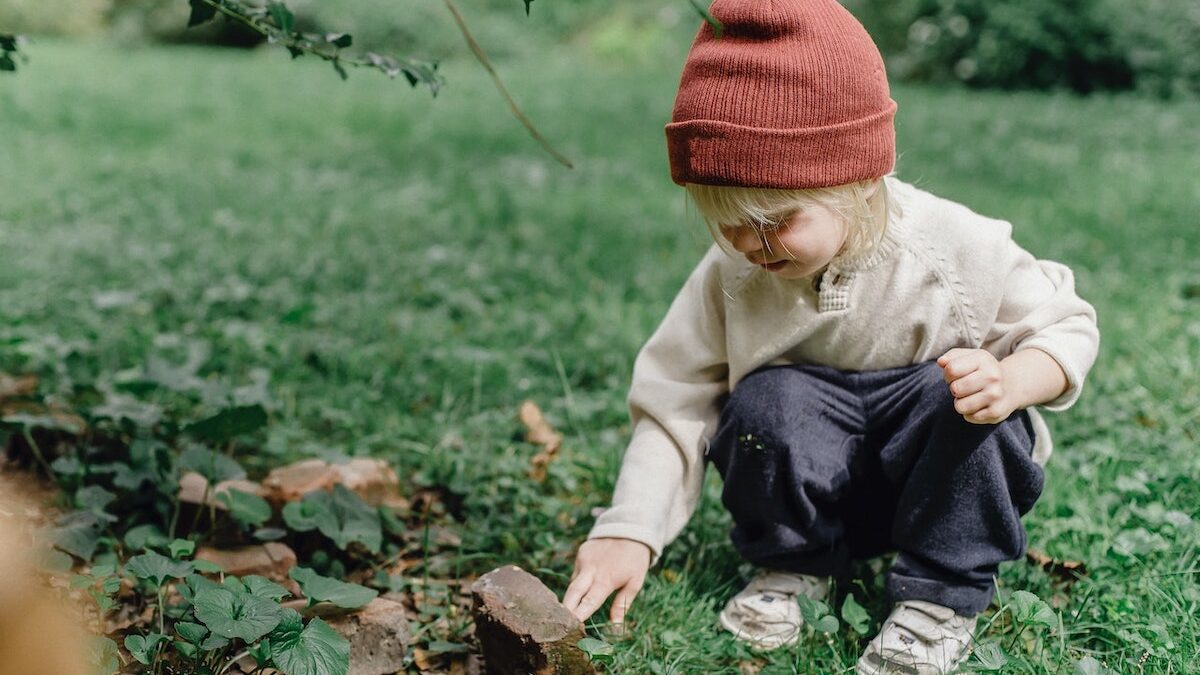Remember growing up in the “good old days” when we didn’t have iPads, iPods, laptops or the internet? Play mostly happened outdoors—running around in the backyard, riding our bikes or making mud pies from the dirt in the flower beds.
Now more than ever, kids are feeling the pull to play inside. It can seem so much more fun to play in the house when you have access to computers and video games after all.
How can we as parents encourage our kids to play outside and make it the opposite of boring? And what is the best outdoor play equipment to make it even more enticing?
Keep reading to find out.
The benefit of natural environments
We all intuitively know that being outside is good for us. We don’t need to be told; our feelings will tell us if we just check in with them. Taking deep breaths in the fresh open air, feeling the sun on your skin, the breeze on your face and hearing birds sing just does something to you. It makes you feel relaxed, happy and carefree. It makes time stand still.
That’s exactly what we need. Both children and adults need to live as much as possible “outside of time”. Our society is driven by the stress of time—we never have enough and we’re always racing against time. But, when you’re sitting in a garden, looking at the flowers and watching the clouds, time is forgotten.
Nature affects your mood and mental health positively, but it also improves your physical health.
- Vitamin D from the sun is an essential component for a strong immune system and also protects against depression.
- People who spend time in nature are more likely to be physically fit as they often use their time walking, running, climbing or bike riding. These all promote muscle strength and tone, and general overall wellbeing.
- Studies have also shown that time in nature can lower blood pressure and stress hormone levels, increase self-esteem and reduce anxiety.
How to make outdoor play work
If you’re thinking, Okay okay. I know it’s good to get outdoors, but how can I convince my kids? Here’s how.
1. Lead by example
We all know our children copy pretty much whatever we do. If you’re lying on your bed doing the “death scroll” on Facebook, you’re showing them how to spend their free time. As soon as they have a phone, they’ll be doing the same.
Get outside. Be goofy and creative. Use your imagination and don’t be embarrassed. These are moments with you that your children will always remember.
2. Make use of resources
If you were thinking you need a tennis court or basketball hoop to make outdoor play fun, think again. The resources are not the most important part of outdoor play, although they can help. You may only have access to dirt, grass, rocks and a tree, but that’s enough to spend loads of time doing fun things.
You can paint rocks, document the bugs and beetles that live in the garden or make a tree house. Sometimes kids have the most fun making things from scratch, without needing “toys” to help them.
3. Unstructured outdoor play
The whole point of play is to let your child’s imagination and creativity express themselves. Don’t try to set limits on creativity (unless of course, it’s physically unsafe). Focus on your child being as unstructured as possible. Let them be innovative, think outside the box, experiment and problem-solve.
4. Offer resources
Yes, we did say this is not the most important part of outdoor play. However, additional outdoor play resources can help keep kids outside and improve learning.
Local parks are a great free resource and it’s amazing how many different games kids will come up with when faced with just a set of swings and a slide. These places can definitely help with gross and fine motor skill development, and also teach social skills. Some playgrounds even have a sandpit which is a child’s absolute dream.
Another healthy way you can have some great outdoor fun with your child is by creating a garden together. It’s incredibly rewarding and fun for a child when they get to pick and eat food that they have grown from their own garden.
5. Don’t forget adult supervision
No child wants to be out in the big wide world alone, with the potential of hurting themselves or being hurt by something or someone. They not only want your company but they need it. As a parent, you have advanced insight that a child doesn’t yet have, and you have the ability and responsibility to not only protect them but teach them the beauties of nature.
4 of the best outdoor play equipment
Some of the best birthday gifts your child will ever enjoy are the ones they get to use outside. So, when you’re next shopping for a birthday present, consider investing in some outdoor play equipment for your child that’s durable and multipurpose.
Some great options are:
- Swing set. These can be used by toddlers (with supervision) all the way up to teenagers.
- Monkey bars or climbing gym. Great for almost any age, and can teach balance (and gravity) and improve physical strength.
- Sandpit. Cost-effective, durable and reusable over and over again. This is a great addition to any outdoor space.
- Sensory garden. Set up a corner with water features, plants, tools, buckets and maybe even a bird feeder to get some creative play happening.
Remember, kids’ outdoor play equipment doesn’t need to be super expensive or take up the whole backyard. It can be super simple and budget-friendly and yet still make for a great outdoor time. The main thing is that you and your child are enjoying the fresh air, physical activity, and unstructured and imaginative play in a variety of different ways.
The family that plays together stays together
Imagine you and everyone in your family, unplugged, off the couch, off the phone and outside. Imagine running across a field kicking a ball together or laughing in a park swinging on swings. Imagine building sandcastles on the beach and splashing through the waves.
How would you feel to see your child connect with nature, noticing the caterpillars and ants, learning how to read the weather from the clouds or feeling a strong sense of direction by discovering the compass in the night sky?
Children don’t need a lot of material stuff to be happy. Early childhood centres are realising this more and more by moving away from indoor and outdoor toys, and creating more green spaces for kids to experiment in nature, using the materials they find in the natural environment.
Outdoor activities are fun, healthy and educational: They improve physical development, mood and creativity. There are so many outdoor play options that will suit all kids’ ages, from six months to three years and beyond.
Remember, the outdoor environment needs to be safe, supervised and fun. You don’t need a huge backyard or a lot of equipment. Even if you have a small patch of lawn, it can be the perfect size when coupled with a good sense of imagination and creativity.
Whether you have older children or younger children, with the right bit of encouragement and company, they can fall in love with nature.

How helpful was this article?
Click on a star to rate it!
0 / 5. 0
Be the first to rate this post!
Adriana Wales
Related posts
Subscribe
Receive personalised articles from experts and wellness inspiration weekly!

